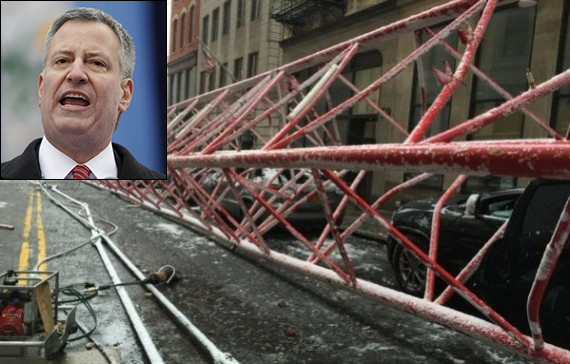Trending
De Blasio announces new crane safety regulations in wake of fatal collapse
Crawler crane activity will be limited in run-up to high winds

Mayor Bill de Blasio announced a series of new regulations governing the use of cranes in the city, following Friday’s crane collapse in Tribeca that killed one pedestrian and injured three other people.
Effective Monday, all crawler cranes will be required to halt operations and go into safety mode whenever winds are even forecast to exceed 20 miles per hour or with gusts exceeding 30 miles per hour — even if that requires securing a crane the day before the winds are forecast to begin.
Crane engineers, who will be advised by the Department of Buildings when such conditions arise, will have to certify their compliance with the DOB or risk violations. There are currently 376 crawler cranes active in New York City, the mayor said.
The penalty for failing to safeguard a crane will also be upped, to $10,000 from $4,800, de Blasio said, speaking at a press conference Sunday at Worth and Church streets.
The city is also calling for increased protection for pedestrians in the immediate area of crane activity. The Department of Transportation will require pedestrian traffic managers to secure the area on projects in high-pedestrian traffic zones. The city will issue violations to crane firms and operators if those flaggers are not appropriately restricting the traffic.
Crane operators will also be required to notify residents and businesses when moving a crane. They are currently only required to notify them when a crane is first installed at a site.
The city is slated to convene a working group to brainstorm even more ideas for improving crane safety in the wake of the disaster. It was not immediately clear who would serve on the working group.
“While the city needs to continue to grow, it must do so in a way in which the safety of workers and the public is paramount,” said John Banks, president of the Real Estate Board of New York, in a statement. “We are committed to working with Mayor de Blasio and Department of Buildings Commissioner Chandler to ensure that the highest safety measures are in place at work sites throughout the city.”
Meanwhile, the investigation into Friday’s events, including a forensic investigation of the construction equipment, is ongoing and could take weeks or months, de Blasio said. All crane activity came to a halt on Friday following the crane collapse, which killed David Wichs, 38, of Manhattan, and injured three others. All three of the injured have now been released from hospital, de Blasio said.
DOB records show that crane use was approved at 60 Hudson on Jan. 12. Permits were approved in October for renovations on the third, sixth and 24th floors. The property is owned by the Stahl Organization, Williams Real Estate and Meyer Equities.
“Was it the equipment, was it the wind, was it some other factor?” de Blasio said. “We literally do not know.”
But, he added, the crane crew “was doing exactly what they were supposed to do at that time.”




